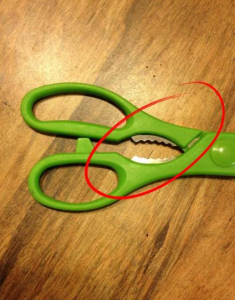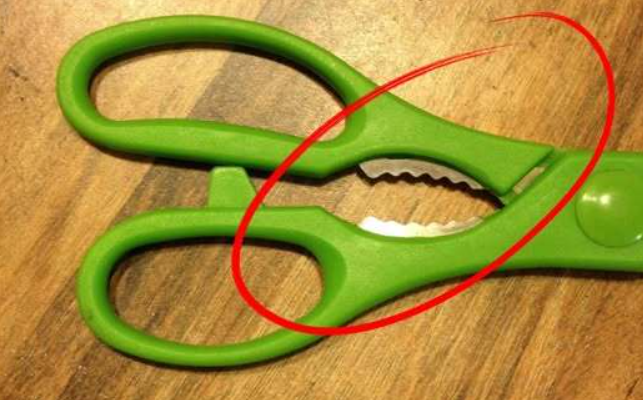What Is That Weird Toothed Part on Kitchen Scissors For?
If you’ve ever picked up a pair of kitchen scissors and noticed a strange toothed or serrated section near the pivot point—sometimes called a notch or gripping tooth—you might have wondered: what exactly is that for? It looks like a tiny, rugged claw hidden between the blades, unlike the smooth cutting edges we usually associate with scissors. Is it decorative? A design quirk? Or does it serve a practical purpose?
In this article, we’ll explore the function of that odd little toothed part on kitchen scissors, why it’s there, how to use it effectively, and how it makes kitchen scissors a truly versatile tool beyond simple cutting.
The Anatomy of Kitchen Scissors
Before diving into the toothed part’s role, let’s quickly look at the general structure of kitchen scissors. Unlike regular paper scissors, kitchen scissors are designed for a variety of tough household tasks beyond slicing thin paper—they cut through meat, herbs, packaging, plastic, and sometimes even tougher materials like bones or shells.
To accomplish this, kitchen scissors often feature:
-
Sharp, durable blades with a slightly serrated edge to grip slippery food.
-
Strong pivot joints that provide the leverage to cut tougher materials.
-
Additional features like bottle openers, nutcrackers, or that mysterious toothed section near the pivot.
What Is That Toothed Part?
The “weird toothed part” is typically a small serrated or ridged area located near the hinge or pivot point of the scissors, often between the handles or just where the blades meet. Sometimes called a gripping notch, a bottle opener notch, or a nutcracker, this part looks like two rough, interlocking teeth.
It’s designed for gripping, cracking, or crushing, rather than cutting. This multifunctional feature adds a surprising amount of utility to your kitchen scissors.
Primary Functions of the Toothed Part
1. Nutcracker or Shell Cracker
One of the most common uses for this toothed section is cracking nuts or shells. When you place a walnut, hazelnut, crab claw, or shellfish limb between the teeth and squeeze the handles, the ridged surface grips the object firmly and applies pressure, breaking the shell without the nut or meat slipping away.
This function is especially handy because it means you don’t need a separate nutcracker or seafood cracker tool cluttering your kitchen drawers. The scissors double as a compact, efficient cracking device.
2. Bottle Opener
In some designs, this toothed part also doubles as a bottle opener. The notch can catch the underside of a bottle cap, allowing you to pry it off with leverage from the handles. While not all kitchen scissors include this feature, many multifunctional models do.
This integration of tasks is a hallmark of kitchen scissors designed for utility and convenience.
3. Gripping and Holding Slippery Items
When dealing with slippery or rounded items like herbs, garlic cloves, or small vegetables, the toothed part acts like a pair of pliers or a grip. It prevents the item from spinning or sliding as you cut or peel, giving you better control.
For example, when chopping herbs finely, you might use the toothed section to grip a small bunch firmly while you snip through it with the blades, avoiding the frustration of things slipping out of place.
4. Breaking or Cracking Small Bones
For those who cook a lot of meat, especially poultry, the toothed section is invaluable for cracking small bones, such as chicken wing joints. It’s a gentle but firm tool to snap bones cleanly, allowing easier carving or preparation without resorting to a heavy cleaver or knife.
Why Is This Feature Important in Kitchen Scissors?
The kitchen is a place of versatility, and tools that serve multiple purposes help save space, time, and effort. The toothed section on kitchen scissors reflects this philosophy.
-
Space-saving: Instead of buying a separate nutcracker, seafood cracker, or bottle opener, you have these functions integrated into a single tool.
-
Efficiency: You can switch between tasks quickly without changing tools, speeding up food prep.
-
Grip: The serrated teeth provide better grip than smooth surfaces, especially for slippery or rounded objects.
How to Use the Toothed Part Safely and Effectively
If you haven’t tried using this toothed notch, here’s a quick guide:
-
Cracking Nuts or Shells: Place the nut or shell between the teeth near the pivot. Hold the handles firmly and squeeze gently but steadily until the shell cracks. Avoid excessive force to prevent crushing the nutmeat inside.
-
Opening Bottles: Hook the notch under the bottle cap lip and use the handle as a lever. Lift carefully to pop the cap.
-
Gripping Small Items: Place herbs, garlic cloves, or small veggies in the toothed notch to hold them steady while cutting.
-
Breaking Bones: Use the toothed part to apply gentle pressure on joints or small bones to snap them cleanly.
Always ensure your fingers are clear of the blades and toothed section to avoid pinching or injury. Keep the scissors clean and dry after use to maintain grip efficiency and hygiene.
Cleaning and Maintenance
Because the toothed part often deals with sticky, oily, or hard foods, it’s important to clean it regularly. Food particles can get trapped between the teeth, reducing grip and potentially harboring bacteria.
-
Wash the scissors immediately after use with warm, soapy water.
-
Use a small brush or toothpick to remove stuck bits from the toothed section.
-
Dry thoroughly to prevent rust or corrosion.
-
Occasionally oil the pivot to maintain smooth operation.
Variations in Design
Not all kitchen scissors have this toothed feature, but those that do often vary in shape and size. Some have more pronounced teeth for heavy-duty cracking, while others have subtle serrations primarily for grip.
Premium or multipurpose models may combine this toothed notch with other handy tools on the handle, such as a built-in bottle opener, screwdriver tip, or vegetable peeler.
When shopping for kitchen scissors, consider how often you’ll use these multifunction features and choose a design that fits your cooking style.
Beyond the Kitchen: Other Uses for the Toothed Part
While designed for kitchen use, the toothed notch on scissors can come in handy in other situations:
-
Opening stubborn packaging or plastic seals.
-
Cracking small hard candies or chocolate shells.
-
Holding small craft materials steady while cutting.
-
Emergency uses like breaking small locks or twisting caps.
Its robust grip and leverage capabilities make it a versatile mini-tool beyond food prep.
Final Thoughts
That weird toothed part on your kitchen scissors isn’t just a quirky design choice—it’s a practical, multifunctional feature crafted to enhance your culinary toolkit. From cracking nuts and shells to opening bottles and gripping slippery items, it embodies efficiency, convenience, and thoughtful design.
Next time you pick up your kitchen scissors, don’t overlook that little toothed notch near the pivot. Give it a try—you might be surprised how often it comes in handy and how it elevates the humble kitchen scissors into a true multitasking marvel.


